
With millions of Americans saddled with seemingly insurmountable levels of student debt, some are calling into question the practicality of obtaining a four-year college degree. Still, the share of Americans who have earned a bachelor’s degree rose last year. As of 2016, 31.3% of Americans age 25 and older had a bachelor’s degree or higher — up from 30.6% the previous year and 29.1% in 2012.
Better educated populations tend to benefit from a range of positive socioeconomic outcomes. American adults with a bachelor’s degree generally earn higher incomes, are less susceptible to serious financial hardship, and are more desirable candidates for employers.
24/7 Wall St. ranked each state by the share of adults 25 and older with at least a bachelor’s degree. In the most educated state, 42.7% of adults have a four-year college degree, more than double the share of 20.8% in the least educated state.
Click here to see the most and least educated states.
Click here to see our detailed findings and methodology.
Editor’s note: Due to a fact-checking error, Idaho was incorrectly referred to as Iowa in a previous version of this article. This error has been corrected.

1. Massachusetts
> Pct. of adults with at least a bachelor’s degree: 42.7%
> Median earnings for bachelor’s degree holders: $60,503 (4th highest)
> Median household income: $75,297 (4th highest)
> 2016 unemployment: 3.7% (10th lowest)
Massachusetts is the only state in the country where over 40% of residents 25 and older have at least a four-year college degree. The share of adults with a bachelor’s degree is also increasing faster in the Bay State than across the country on the whole. The share of college educated adults climbed by 1.2 percentage points between 2015 and 2016, the fifth highest increase among states.
[in-text-ad]

2. Colorado
> Pct. of adults with at least a bachelor’s degree: 39.9%
> Median earnings for bachelor’s degree holders: $51,136 (17th highest)
> Median household income: $65,685 (12th highest)
> 2016 unemployment: 3.3% (7th lowest)
Adults with college degrees are more likely to have higher paying jobs than those with only a high school diploma. In Colorado, 39.9% of the adults age 25 and older have at least a bachelor’s degree, well above the 31.3% share of American adults. Partially as a result, the typical Colorado household earns $65,685 a year, well above the $57,617 the typical American household earns.

3. Maryland
> Pct. of adults with at least a bachelor’s degree: 39.3%
> Median earnings for bachelor’s degree holders: $61,049 (3rd highest)
> Median household income: $78,945 (the highest)
> 2016 unemployment: 4.3% (19th lowest)
High-skilled, high-paying jobs are often only available to individuals with a college degree or higher. In Maryland, 15.6% of the labor force are employed in the professional, scientific, and management sector, the largest such share of any state. High employment in such a high skilled industry would likely not be possible in many states with a smaller share of college educated adults. Maryland’s 39.3% bachelor’s degree attainment rate is higher than that of all but two other states.

4. Connecticut
> Pct. of adults with at least a bachelor’s degree: 38.6%
> Median earnings for bachelor’s degree holders: $61,257 (2nd highest)
> Median household income: $73,433 (6th highest)
> 2016 unemployment: 5.1% (16th highest)
Connecticut’s 38.6% share of residents with at least a bachelor’s degree is the second highest in New England and fourth highest in the United States. In general, higher educational attainment leads to higher annual incomes and in Connecticut, a four-year college degree is more valuable than in most other states. The typical college educated adult in Connecticut earns $61,257 a year, more than in every other state except for New Jersey, and nearly $10,000 more than is typical nationwide.
[in-text-ad-2]

5. New Jersey
> Pct. of adults with at least a bachelor’s degree: 38.6%
> Median earnings for bachelor’s degree holders: $62,300 (the highest)
> Median household income: $76,126 (3rd highest)
> 2016 unemployment: 5.0% (18th highest)
A four-year college degree is one of the most practical ways for Americans to increase their earning potential. In New Jersey, bachelor’s degree holders are more highly compensated than in any other state. The typical college graduate in the Garden State earns $62,300 a year — well above the comparable $51,676 median income among all Americans with a four-year degree. Some 38.6% of adults in New Jersey have a bachelor’s degree, the fifth highest share among states and a full percentage point increase over the 2015 share.

6. Virginia
> Pct. of adults with at least a bachelor’s degree: 38.1%
> Median earnings for bachelor’s degree holders: $56,324 (8th highest)
> Median household income: $68,114 (8th highest)
> 2016 unemployment: 4.0% (15th lowest)
A concentration of employment in high skill sectors is often indicative of higher educational attainment across a population. In Virginia, 15.4% of the labor force works in the professional, scientific, and management sector — the second largest share of any U.S. state. Employment in the sector is likely primarily fueled by the far larger than typical 38.1% of Virginians age 25 and older with a bachelor’s degree.
[in-text-ad]

7. New Hampshire
> Pct. of adults with at least a bachelor’s degree: 36.6%
> Median earnings for bachelor’s degree holders: $51,823 (14th highest)
> Median household income: $70,936 (7th highest)
> 2016 unemployment: 2.8% (2nd lowest)
Not only do adults with a bachelor’s degree tend to have greater earnings potential, but they are also often more desirable candidates for employers. New Hampshire’s far greater than typical 36.6% bachelor’s degree attainment rate may partially explain the state’s healthy economy. An average of only 2.8% of New Hampshire’s labor force were out of a job in 2016, the second lowest annual unemployment rate among states, and well below the comparable 4.9% U.S. rate.

8. Vermont
> Pct. of adults with at least a bachelor’s degree: 36.4%
> Median earnings for bachelor’s degree holders: $42,338 (7th lowest)
> Median household income: $57,677 (20th highest)
> 2016 unemployment: 3.3% (7th lowest)
Unlike the nation as a whole, the share of college-educated adults remained effectively unchanged in Vermont from 2015 to 2016. Still, 36.4% of Vermonters age 25 and up have at least a college degree, considerably larger than the 31.3% share of American adults. Though incomes tend to be higher in populations with greater educational attainment, the median household income in Vermont of $57,677 a year is roughly in line with the median household income nationwide.

9. New York
> Pct. of adults with at least a bachelor’s degree: 35.7%
> Median earnings for bachelor’s degree holders: $56,868 (7th highest)
> Median household income: $62,909 (14th highest)
> 2016 unemployment: 4.8% (25th highest)
Some 35.7% of adults in New York state have at least a four-year college degree, considerably more than the 31.3% share of American adults. Employment concentration by sector can often be indicative of education levels of a given population — and New York is no exception. Employment is higher than typical in New York in sectors that often demand at least a college education — like information and finance and insurance. Meanwhile, employment is less common in New York in sectors with less stringent educational standards like manufacturing and construction.
[in-text-ad-2]

10. Washington
> Pct. of adults with at least a bachelor’s degree: 35.1%
> Median earnings for bachelor’s degree holders: $58,262 (6th highest)
> Median household income: $67,106 (10th highest)
> 2016 unemployment: 5.4% (9th highest)
Washington state’s bachelor’s degree attainment rate of 35.1% is considerably higher than the 31.3% share of adults nationwide with at least a four-year college degree. States with higher bachelor’s degree attainment rates tend to have higher median incomes — and Washington is no exception. The typical household in the state earns $67,106 annually, about $9,500 more than the median household income nationwide.

11. Minnesota
> Pct. of adults with at least a bachelor’s degree: 34.8%
> Median earnings for bachelor’s degree holders: $54,749 (10th highest)
> Median household income: $65,599 (13th highest)
> 2016 unemployment: 3.9% (13th lowest)
In a break from the nationwide trend, the share of adults with a bachelor’s degree remained effectively unchanged in Minnesota from 2015 to 2016. Despite the slight uptick nationwide, the 34.8% share of adults in Minnesota with at least a four-year college diploma remains higher than in most states and than the 31.3% U.S. figure.
A better educated population is more likely to command higher salaries and less likely to face serious financial hardship. Only about 1 in every 10 Minnesota residents live below the poverty line, one of the smallest shares of any state and well below the 14.0% U.S. poverty rate.
[in-text-ad]

12. Rhode Island
> Pct. of adults with at least a bachelor’s degree: 34.1%
> Median earnings for bachelor’s degree holders: $52,045 (13th highest)
> Median household income: $60,596 (18th highest)
> 2016 unemployment: 5.3% (13th highest)
Rhode Island is the second least educated state in the New England region. Still, 34.1% of adult residents have at least a bachelor’s degree, a larger share than in most states and well above the 31.3% share of adults nationwide.
States with high educational attainment rates typically have strong economies. Rhode Island is a notable exception, however. Some 5.3% of the state’s labor force is out of a work — a higher unemployment rate than in most states and the 4.9% annual U.S. rate.
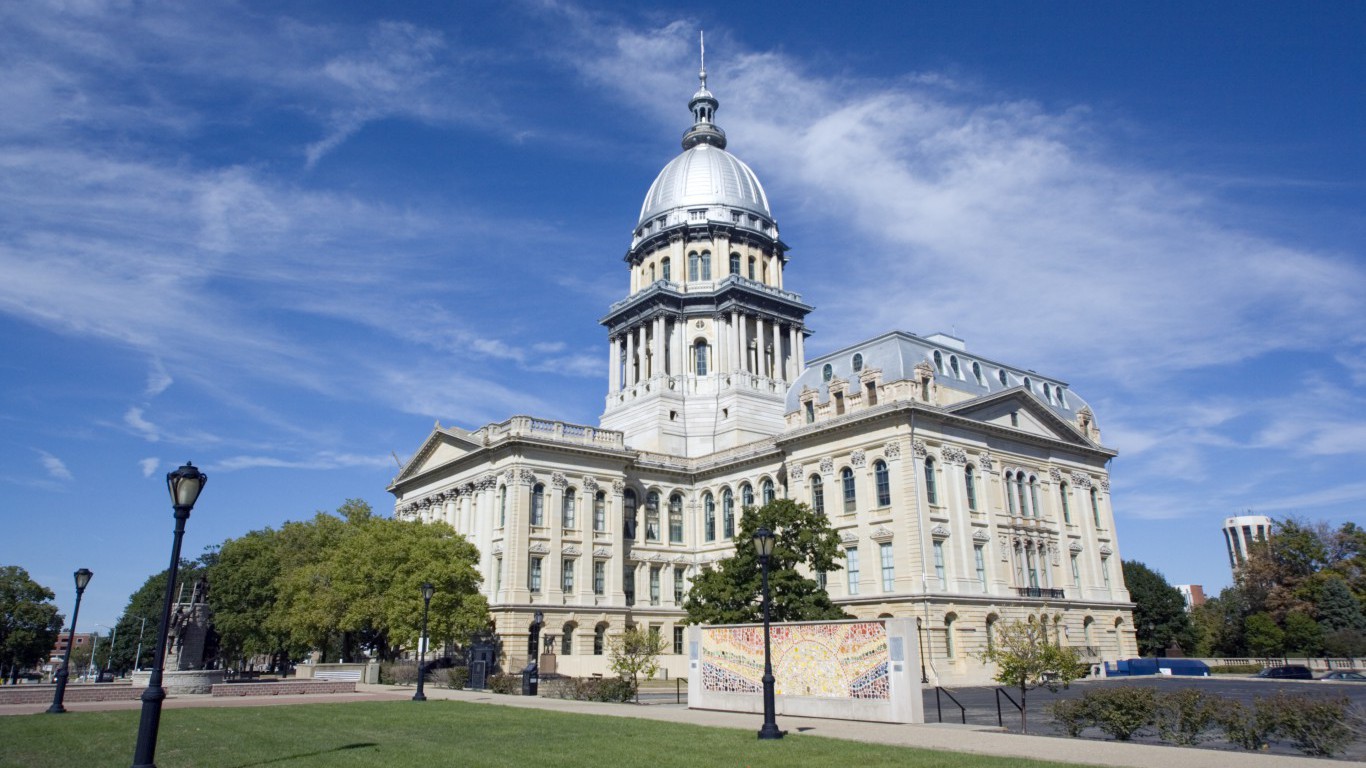
13. Illinois
> Pct. of adults with at least a bachelor’s degree: 34.0%
> Median earnings for bachelor’s degree holders: $55,161 (9th highest)
> Median household income: $60,960 (16th highest)
> 2016 unemployment: 5.9% (6th highest)
Most states that are home to a larger than average share of adults with at least a bachelor’s degree have relatively strong economies. Illinois is an exception. Some 34.0% of state residents 25 and older have at least a bachelor’s degree, more than the 31.3% share of American adults. Despite the higher skilled talent pool for employers across the state to draw from, 5.9% of Illinois’ workers are out of a job — one of the highest unemployment rates of any state and well above the 4.9% annual U.S. unemployment rate.
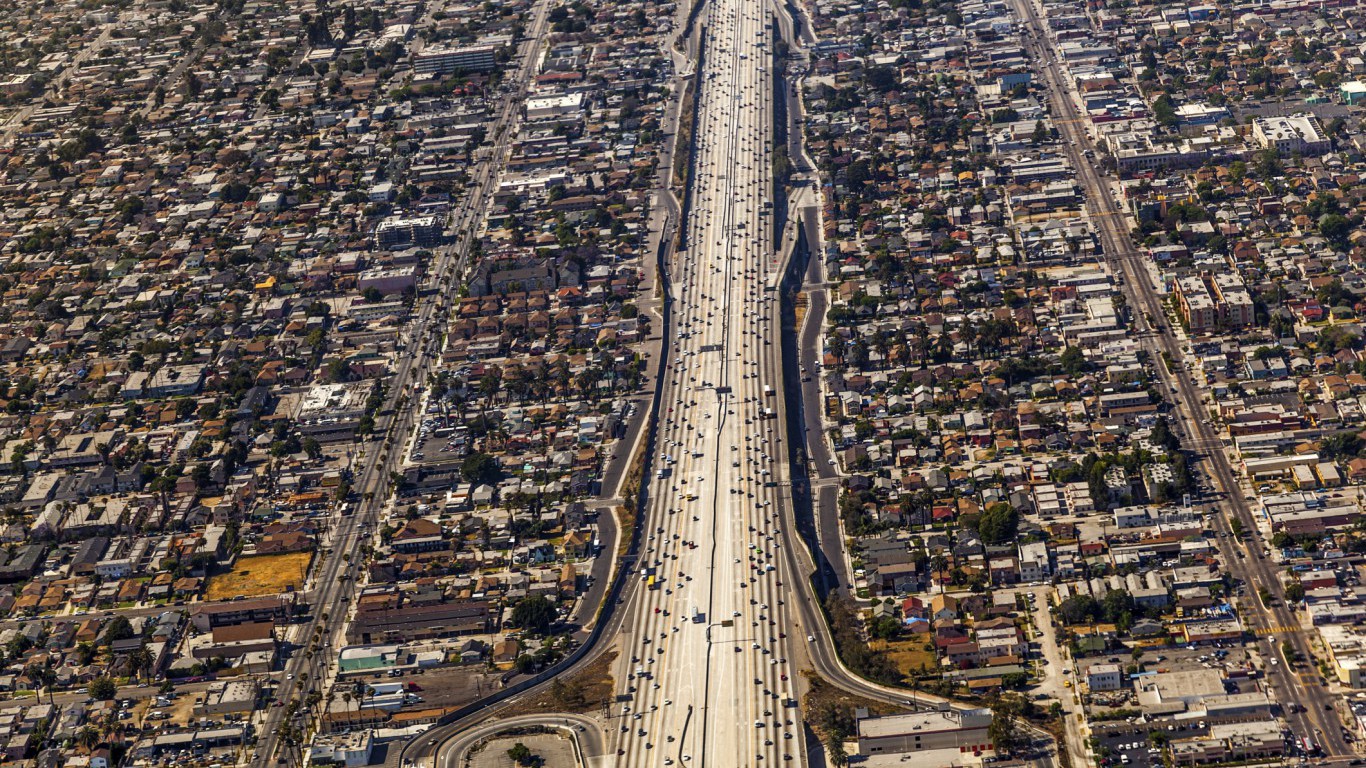
14. California
> Pct. of adults with at least a bachelor’s degree: 32.9%
> Median earnings for bachelor’s degree holders: $60,121 (5th highest)
> Median household income: $67,739 (9th highest)
> 2016 unemployment: 5.4% (9th highest)
Only 82.4% of adults in California have completed high school — the smallest share of any state. A high school diploma is a prerequisite for a college degree, but despite the poor high school diploma attainment rate, adults in California are more likely than most American adults to have a college education. Some 32.9% of Californians 25 and older have a four-year college degree compared to 31.3% of American adults nationwide.
A college education appears to be a worthwhile investment in California. The typical college graduate in the state earns about $30,000 more a year than the typical high school graduate — the largest such income gap of any state after New Jersey.
[in-text-ad-2]

15. Kansas
> Pct. of adults with at least a bachelor’s degree: 32.8%
> Median earnings for bachelor’s degree holders: $46,772 (17th lowest)
> Median household income: $54,935 (23rd lowest)
> 2016 unemployment: 4.2% (18th lowest)
Across broad populations, areas with a larger share of college-educated adults tend to also report higher incomes. Kansas is a notable exception. Even though 32.8% of adults in the state have a four-year college degree compared to 31.3% of adults nationwide, the typical Kansas household earns only $54,935 a year, considerably less than the median household income nationwide of $57,617.
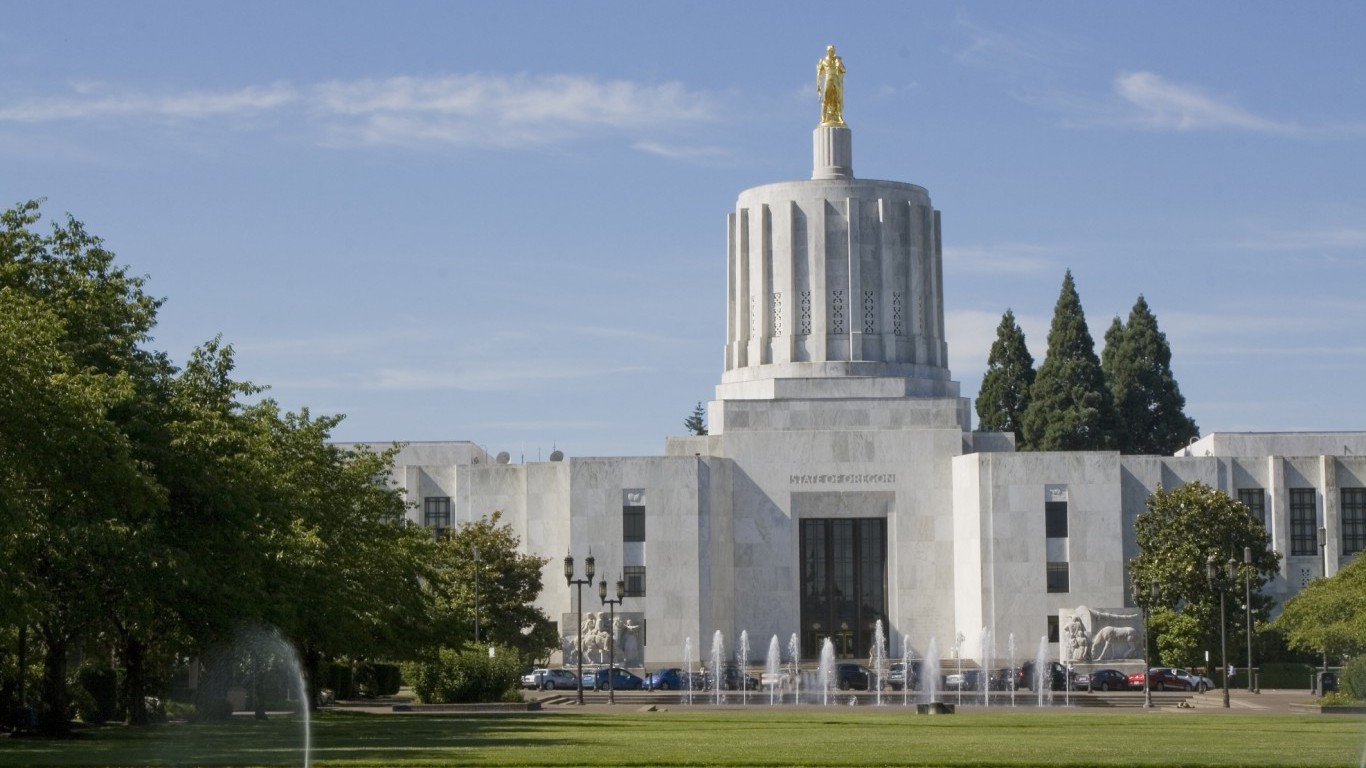
16. Oregon
> Pct. of adults with at least a bachelor’s degree: 32.7%
> Median earnings for bachelor’s degree holders: $46,942 (20th lowest)
> Median household income: $57,532 (21st highest)
> 2016 unemployment: 4.9% (20th highest)
Breaking from the national trend, the share of adults with a college education remained effectively unchanged in Oregon between 2015 and 2016. Despite a nationwide increase in the share of adults with a bachelor’s degree, Oregon’s 32.7% share of adults with a four-year diploma remains higher than the comparable U.S. share of 31.3%.
Incomes often increase with education attainment, and despite Oregon’s more educated population, the typical household in the state earns $57,532 a year, roughly in line the with the $57,617 median income nationwide.
[in-text-ad]

17. Utah
> Pct. of adults with at least a bachelor’s degree: 32.6%
> Median earnings for bachelor’s degree holders: $47,164 (22nd lowest)
> Median household income: $65,977 (11th highest)
> 2016 unemployment: 3.4% (8th lowest)
States with higher than typical educational attainment rates often have strong economies — and Utah is no exception. Some 32.6% of adults 25 and older in the state have a bachelor’s degree, a larger share than in most states and above the comparable 31.3% U.S. educational attainment rate. With a well-educated labor force, joblessness is relatively uncommon in Utah. Only 3.4% of the state’s labor force is out of a job, one of the lower unemployment rates among states and far better than the 4.9% annual unemployment nationwide.

18. Hawaii
> Pct. of adults with at least a bachelor’s degree: 31.9%
> Median earnings for bachelor’s degree holders: $49,440 (23rd highest)
> Median household income: $74,511 (5th highest)
> 2016 unemployment: 3.0% (3rd lowest)
In Hawaii, 31.9% of adults have a bachelor’s degree, roughly in line with the 31.3% share of American adults. Despite comparable educational attainment only 3.0% of Hawaii’s workers were out of a job in 2016, the third lowest annual jobless rate among states and well below the 4.9% annual U.S. unemployment rate.
Incomes are also relatively high in Hawaii. The typical household in the state earns $74,511 a year, nearly $17,000 more than the typical American household.

19. Nebraska
> Pct. of adults with at least a bachelor’s degree: 31.4%
> Median earnings for bachelor’s degree holders: $46,260 (16th lowest)
> Median household income: $56,927 (22nd highest)
> 2016 unemployment: 3.2% (5th lowest)
The share of adults with a bachelor’s degree in Nebraska climbed from 30.2% in 2015 to 31.4% in 2016 — a stronger improvement than in most states. States with a larger share of college educated residents typically have lower unemployment. Despite the uptick in the college attainment rate, unemployment climbed slightly from 3.0% to 3.2% in Nebraska between 2015 and 2016.
[in-text-ad-2]

20. Delaware
> Pct. of adults with at least a bachelor’s degree: 31.0%
> Median earnings for bachelor’s degree holders: $54,225 (11th highest)
> Median household income: $61,757 (15th highest)
> 2016 unemployment: 4.4% (21st lowest)
Nationwide, the share of adults with bachelor’s degree climbed from 29% in 2012 to 31.3% in 2016. Though the degree of the uptick varied from state to state, the improvement was nearly universal — with only a few exceptions like Delaware. Delaware’s 31.0% bachelor’s degree attainment rate is effectively unchanged since 2012. Similarly, the 89.3% share of state adults with a high school diploma has not changed meaningfully since 2012, while nationwide, the high school attainment rate improved by 1.1 percentage points over the same period.
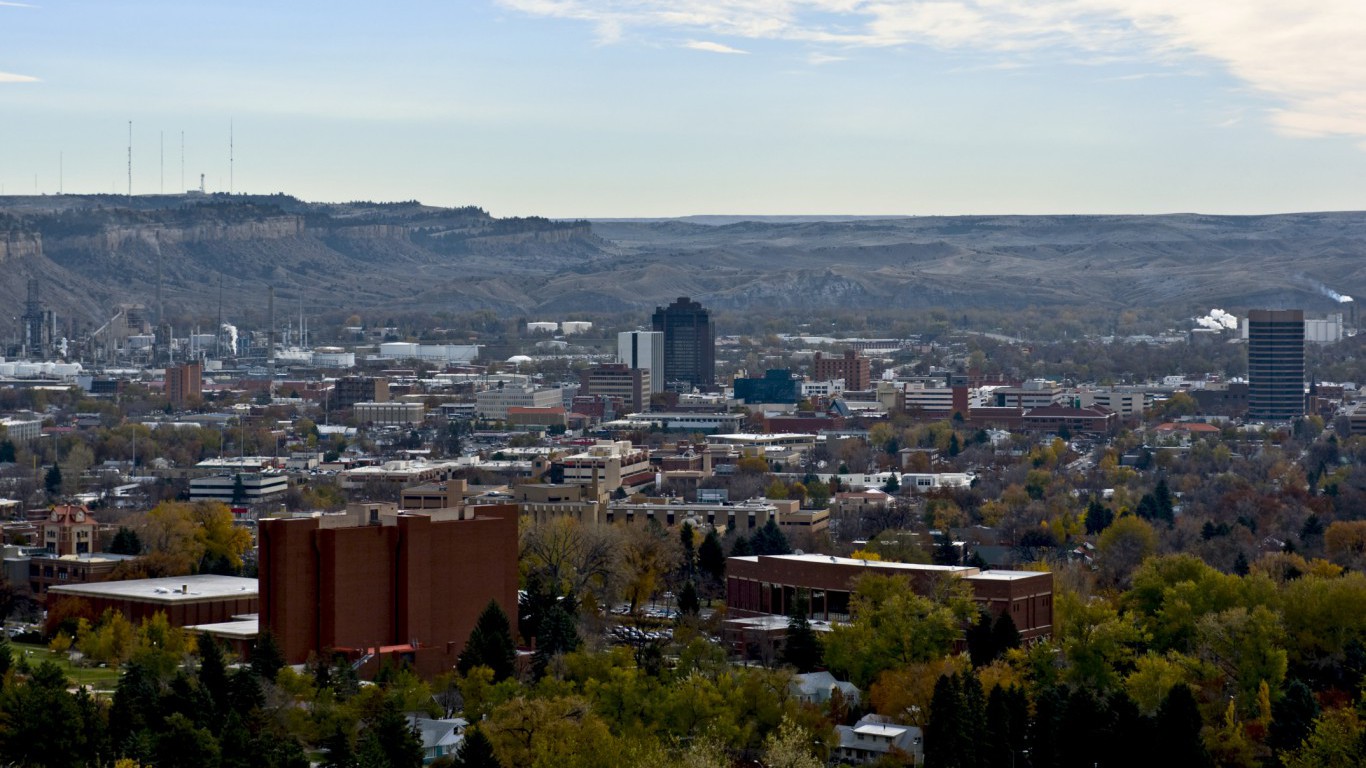
21. Montana
> Pct. of adults with at least a bachelor’s degree: 31.0%
> Median earnings for bachelor’s degree holders: $39,650 (the lowest)
> Median household income: $50,027 (11th lowest)
> 2016 unemployment: 4.1% (17th lowest)
In 2012, 29.4% of adults in Montana had a bachelor’s degree, slightly more than the 29.1% of American adults at the time. As of last year, after only a modest improvement, 31.0% of adults in the state had at least a bachelor’s degree, slightly less than the 31.3% share of adults nationwide. Similarly, 92.8% of adults in Montana have at least a high school diploma — effectively unchanged over the same period.
[in-text-ad]

22. Pennsylvania
> Pct. of adults with at least a bachelor’s degree: 30.8%
> Median earnings for bachelor’s degree holders: $51,199 (16th highest)
> Median household income: $56,907 (23rd highest)
> 2016 unemployment: 5.4% (9th highest)
The share of adults with a bachelor’s degree increased more in Pennsylvania in the last four years than in all but three other states. An estimated 30.8% of Pennsylvania adults have at least a bachelor’s degree, compared to the state’s 2012 college attainment rate of 27.8%. College-educated adults are more likely to hold advanced, high-paying jobs, and they often earn higher incomes than adults who did not graduate from a four-year college. As college attainment rose in Pennsylvania, the median household income rose as well, from $53,539 in 2012 to $56,907 in 2016.

23. Georgia
> Pct. of adults with at least a bachelor’s degree: 30.5%
> Median earnings for bachelor’s degree holders: $50,962 (18th highest)
> Median household income: $53,559 (21st lowest)
> 2016 unemployment: 5.4% (9th highest)
Some 30.5% of adults in Georgia have obtained a four-year college degree — roughly in line with the 31.3% share of American adults. Just as it did nationwide, the share of Peach State adult residents with college degree climbed by just over half a percentage point from 2015.
Meanwhile, the 86.4% share of adults in Georgia with at least a high school education remains effectively unchanged from 2015. Nationwide, 87.5% of adults have at least a high school diploma, up about half a percentage point from 2015.

24. North Carolina
> Pct. of adults with at least a bachelor’s degree: 30.4%
> Median earnings for bachelor’s degree holders: $47,143 (21st lowest)
> Median household income: $50,584 (12th lowest)
> 2016 unemployment: 5.1% (16th highest)
An estimated 30.4% of adults have a bachelor’s degree in North Carolina, slightly less than the 31.3% national figure. Despite nearly average college attainment rate, most North Carolina residents are far less wealthy than the typical American. The typical North Carolina household earns $50,584 a year, much less than the $57,617 national median household income. One factor depressing incomes in North Carolina may be the weak job market. In 2016, 5.1% of North Carolina’s labor force was unemployed, compared to the 4.9% national figure.
[in-text-ad-2]

25. Maine
> Pct. of adults with at least a bachelor’s degree: 30.1%
> Median earnings for bachelor’s degree holders: $43,559 (8th lowest)
> Median household income: $53,079 (19th lowest)
> 2016 unemployment: 3.9% (13th lowest)
While the share of U.S. adults with a bachelor’s degree nationwide rose from 30.6% in 2015 to 31.3% in 2016, in Maine the college attainment rate remained at 30.1%.
A college education pays off less in Maine than it does in most states. The typical bachelor’s degree holder in Maine earns just $15,600 more a year than the typical high school graduate, compared to the $21,700 average difference nationwide. One factor contributing to the relatively low earnings of college graduates may be the lack of advanced industry in Maine. Just 1.5% of Maine workers are employed in information, and just 9.0% in professional and scientific services, among the smallest shares nationwide.

26. Alaska
> Pct. of adults with at least a bachelor’s degree: 29.6%
> Median earnings for bachelor’s degree holders: $51,665 (15th highest)
> Median household income: $76,440 (2nd highest)
> 2016 unemployment: 6.6% (2nd highest)
Some 29.6% of Alaska adults have a bachelor’s degree, less than the 31.3% national share. Despite the lower college attainment rate, the typical Alaska household earns $76,440 a year, the second most of any state. While the difference in median earnings between college and high school graduates is often the greatest in the wealthiest states, in Alaska, the typical bachelor’s degree holder earns just $19,600 more than the typical high school graduate, less than the $21,700 average difference nationwide. One reason for this may be the state’s large oil industry, which can provide high-paying jobs to workers with lower levels of educational attainment.
[in-text-ad]

27. North Dakota
> Pct. of adults with at least a bachelor’s degree: 29.6%
> Median earnings for bachelor’s degree holders: $46,865 (18th lowest)
> Median household income: $60,656 (17th highest)
> 2016 unemployment: 3.2% (5th lowest)
An estimated 29.6% of North Dakota adults currently have a bachelor’s degree, effectively unchanged from the previous year.
While North Dakota lacks many of the advanced industries found in Western and Northeastern states, its robust oil industry offers some high-paying jobs that do not require a college education. Indeed, the typical bachelor’s degree holder in North Dakota earns just $14,200 more a year than the typical high school graduate, the fourth smallest difference of any state.

28. Wisconsin
> Pct. of adults with at least a bachelor’s degree: 29.5%
> Median earnings for bachelor’s degree holders: $50,323 (22nd highest)
> Median household income: $56,811 (24th highest)
> 2016 unemployment: 4.1% (17th lowest)
The share of adults in Wisconsin with at least a bachelor’s degree rose from 28.4% in 2015 to 29.5% in 2016. Despite the rise in educational attainment in Wisconsin, the state’s median household income did not change significantly. The typical Wisconsin household currently earns $56,811 annually, slightly less than the national median household income of $57,617.
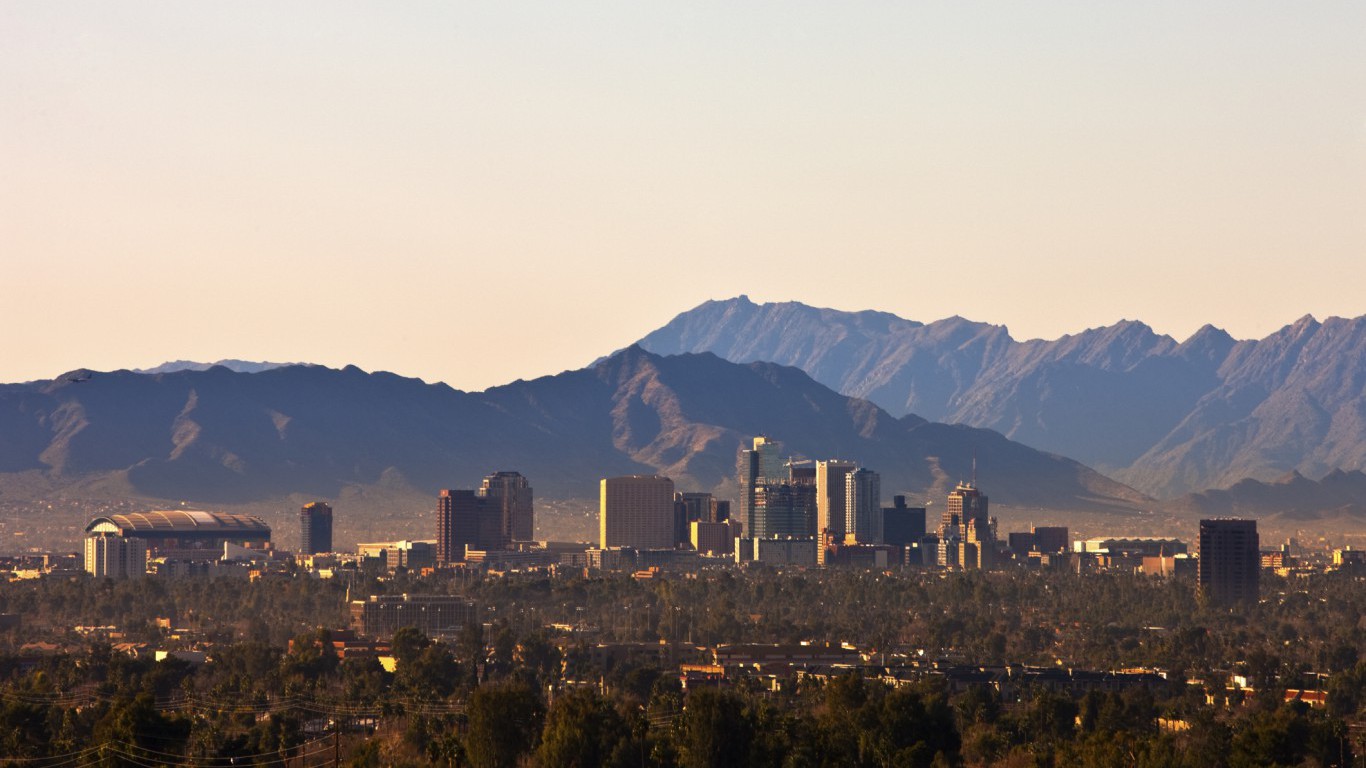
29. Arizona
> Pct. of adults with at least a bachelor’s degree: 28.9%
> Median earnings for bachelor’s degree holders: $50,479 (21st highest)
> Median household income: $53,558 (20th lowest)
> 2016 unemployment: 5.3% (13th highest)
Educational attainment increased more in Arizona than in nearly any other state over the past year. While nationwide the share of adults with at least a bachelor’s degree rose from 30.6% in 2015 to 31.3% in 2016, in Arizona the college attainment rate rose from 27.7% to 28.9%. College graduates in Arizona earn roughly $22,800 more a year than high school graduates, and as educational attainment increased in the state, median household income rose as well. The typical Arizona household earned $53,558 in 2016, approximately $1,500 more than the year prior.
[in-text-ad-2]

30. South Dakota
> Pct. of adults with at least a bachelor’s degree: 28.9%
> Median earnings for bachelor’s degree holders: $42,054 (4th lowest)
> Median household income: $54,467 (22nd lowest)
> 2016 unemployment: 2.8% (2nd lowest)
Though a college education is not always cheap, a college degree can open opportunities to higher paying careers. In South Dakota, an investment in education may not have as high a financial return as in other states. College-educated adults in South Dakota earn a median income of $42,054 a year, the fourth lowest of all states and only about $11,800 higher than the median income of high school graduates in the state. Nationwide, the difference is $21,700.
Only 28.9% of South Dakota residents 25 and older have a four-year college degree compared to 31.3% of American adults.

31. Texas
> Pct. of adults with at least a bachelor’s degree: 28.9%
> Median earnings for bachelor’s degree holders: $52,967 (12th highest)
> Median household income: $56,565 (25th highest)
> 2016 unemployment: 4.6% (23rd lowest)
Some 28.9% of adults in Texas have a bachelor’s degree, up about half a percentage point from the previous year. Despite the improvement, most states are home to a larger share of college educated adults.
The Lone Star State is also home to a relatively large share of adults without a high school diploma. Only 82.9% of Texans 25 and older have completed high school, the second smallest share of any state. Despite low educational attainment rates, the typical Texas household earns $56,565 a year, only slightly less than the $57,617 median income nationwide.
[in-text-ad]

32. Florida
> Pct. of adults with at least a bachelor’s degree: 28.6%
> Median earnings for bachelor’s degree holders: $45,031 (10th lowest)
> Median household income: $50,860 (13th lowest)
> 2016 unemployment: 4.9% (20th highest)
At 28.6%, the share of adults in Florida with at least a college degree is effectively the same as it was in 2015. A college education brings with it higher paying job opportunities — and in Florida, those without a college degree are far more likely than most Americans to face serious financial hardship. The median salary among adults with no more than a high school diploma in the state is only $26,129, the second lowest of any state.

33. Missouri
> Pct. of adults with at least a bachelor’s degree: 28.5%
> Median earnings for bachelor’s degree holders: $45,701 (11th lowest)
> Median household income: $51,746 (14th lowest)
> 2016 unemployment: 4.5% (22nd lowest)
Missouri residents are less likely to be college educated than Americans on the whole. Only 28.5% of the state’s adult population has a bachelor’s degree compared to 31.3% of Americans age 25 and older. Still, the state’s high school diploma attainment rate compares favorably to that of the nation. Some 89.6% of adults in the state have completed high school compared to 87.5% of American adults.

34. Iowa
> Pct. of adults with at least a bachelor’s degree: 28.4%
> Median earnings for bachelor’s degree holders: $48,207 (25th lowest)
> Median household income: $56,247 (25th lowest)
> 2016 unemployment: 3.7% (10th lowest)
The share of Iowa adults with a bachelor’s degree increased by 1.6 percentage points from 2015 to 2016 — the second greatest increase of any state and more than double the increase nationwide. Still, the state’s 28.4% bachelor’s degree attainment rate remains below that of most states and is considerably lower than the 31.3% share nationwide.
[in-text-ad-2]

35. Michigan
> Pct. of adults with at least a bachelor’s degree: 28.3%
> Median earnings for bachelor’s degree holders: $50,821 (20th highest)
> Median household income: $52,492 (18th lowest)
> 2016 unemployment: 4.9% (20th highest)
Just as it did nationwide, the share of adults in Michigan with a bachelor’s degree improved slightly in 2016. Still, the share of adults in the state with a college education of 28.3% remains below the comparable share in most states.
While adults in Michigan are less likely than American adults on the whole to have completed college, they are more likely to have earned a high school diploma. Some 90.4% of state residents 25 and older have finished high school compared to 87.5% of American adults.

36. Idaho
> Pct. of adults with at least a bachelor’s degree: 27.6%
> Median earnings for bachelor’s degree holders: $41,343 (2nd lowest)
> Median household income: $51,807 (15th lowest)
> 2016 unemployment: 3.8% (11th lowest)
The share of adults with a bachelor’s degree or higher climbed by 1.6 percentage points in Idaho between 2015 and 2016, the most substantial improvement of any state. Despite the uptick, most states are home to a larger share of adults with a four-year college degree than Idaho. Only 27.6% of adults in Idaho have a bachelor’s degree compared to 31.3% of adults nationwide.
[in-text-ad]

37. Ohio
> Pct. of adults with at least a bachelor’s degree: 27.5%
> Median earnings for bachelor’s degree holders: $50,830 (19th highest)
> Median household income: $52,334 (17th lowest)
> 2016 unemployment: 4.9% (20th highest)
The typical high school graduate in Ohio earns only about $30,000 a year. Meanwhile, the median income among college graduates in the state is over $50,000 a year. Despite the apparent financial incentive, only 27.5% of adults in Ohio have a bachelor’s degree, less than in the vast majority of states. Nationwide, 31.3% of adults have earned a four-year college degree.
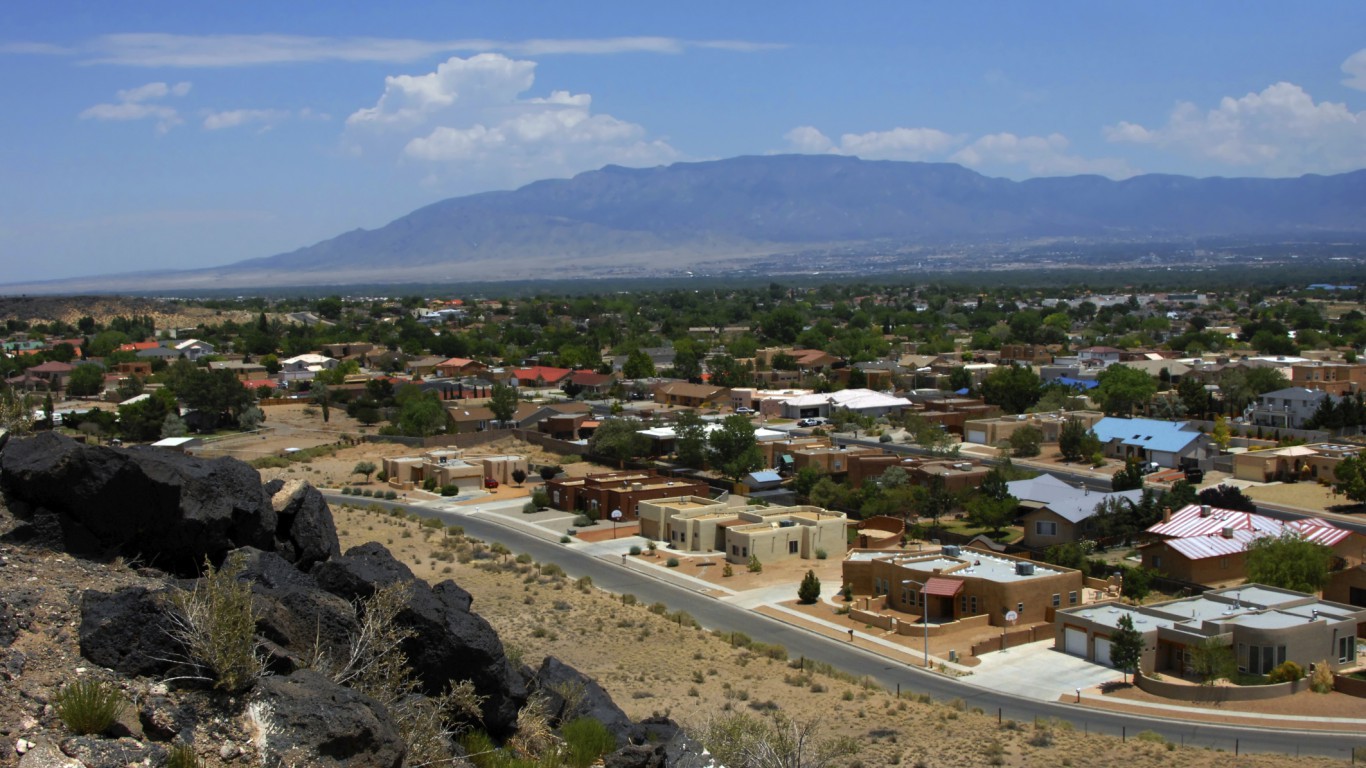
38. New Mexico
> Pct. of adults with at least a bachelor’s degree: 27.2%
> Median earnings for bachelor’s degree holders: $42,021 (3rd lowest)
> Median household income: $46,748 (7th lowest)
> 2016 unemployment: 6.7% (the highest)
Only 27.2% of adults in New Mexico have a bachelor’s degree — well below the 31.3% share of adults nationwide. At $46,748 a year, the median earnings of college-educated adults in New Mexico is lower than in all but six other states. Those without a college degree in New Mexico are at especially high risk of serious financial hardship. The median income among high school graduates in the state is only $25,622 a year, the lowest of any state in the country.

39. South Carolina
> Pct. of adults with at least a bachelor’s degree: 27.2%
> Median earnings for bachelor’s degree holders: $46,083 (14th lowest)
> Median household income: $49,501 (10th lowest)
> 2016 unemployment: 4.8% (25th highest)
South Carolinians are less likely than adults nationwide to have earned a bachelor’s degree. However, a college degree may not be necessary for several of the more common jobs across the state. Some 13.8% of South Carolina’s labor force works in manufacturing, and 12.7% work in retail, each among the largest such shares of any state. The state economy is also faring well. Only 4.8% of the labor force was out of a job in 2016, roughly in line with the 4.9% annual U.S. unemployment rate.
[in-text-ad-2]

40. Wyoming
> Pct. of adults with at least a bachelor’s degree: 27.1%
> Median earnings for bachelor’s degree holders: $47,322 (23rd lowest)
> Median household income: $59,882 (19th highest)
> 2016 unemployment: 5.3% (13th highest)
Some 93.2% of adults in Wyoming have a high school diploma, the largest share of any state in the country. In stark contrast, only 27.1% of adults in the state have a four-year college degree, one of the smaller such shares of any state. Many of the more common jobs in Wyoming do not likely require a college education. A resource rich state, 9.9% of Wyoming’s workforce are employed in agriculture and mining, and 6.5% work in transportation and warehousing, the largest and third largest such shares of any state, respectively.

41. Tennessee
> Pct. of adults with at least a bachelor’s degree: 26.1%
> Median earnings for bachelor’s degree holders: $46,065 (13th lowest)
> Median household income: $48,547 (8th lowest)
> 2016 unemployment: 4.8% (25th highest)
While the share of adults with a college education climbed 0.7 percentage points nationwide in 2016, it remained effectively unchanged in Tennessee. Today, only 26.1% of state residents 25 and older have at least a bachelor’s degree, compared to 31.3% of adults nationwide.
Median incomes tend to be higher in states where more adults have gone to college. In Tennessee, the typical household earns only $48,547 a year, well below the median income nationwide of $57,617.
[in-text-ad]
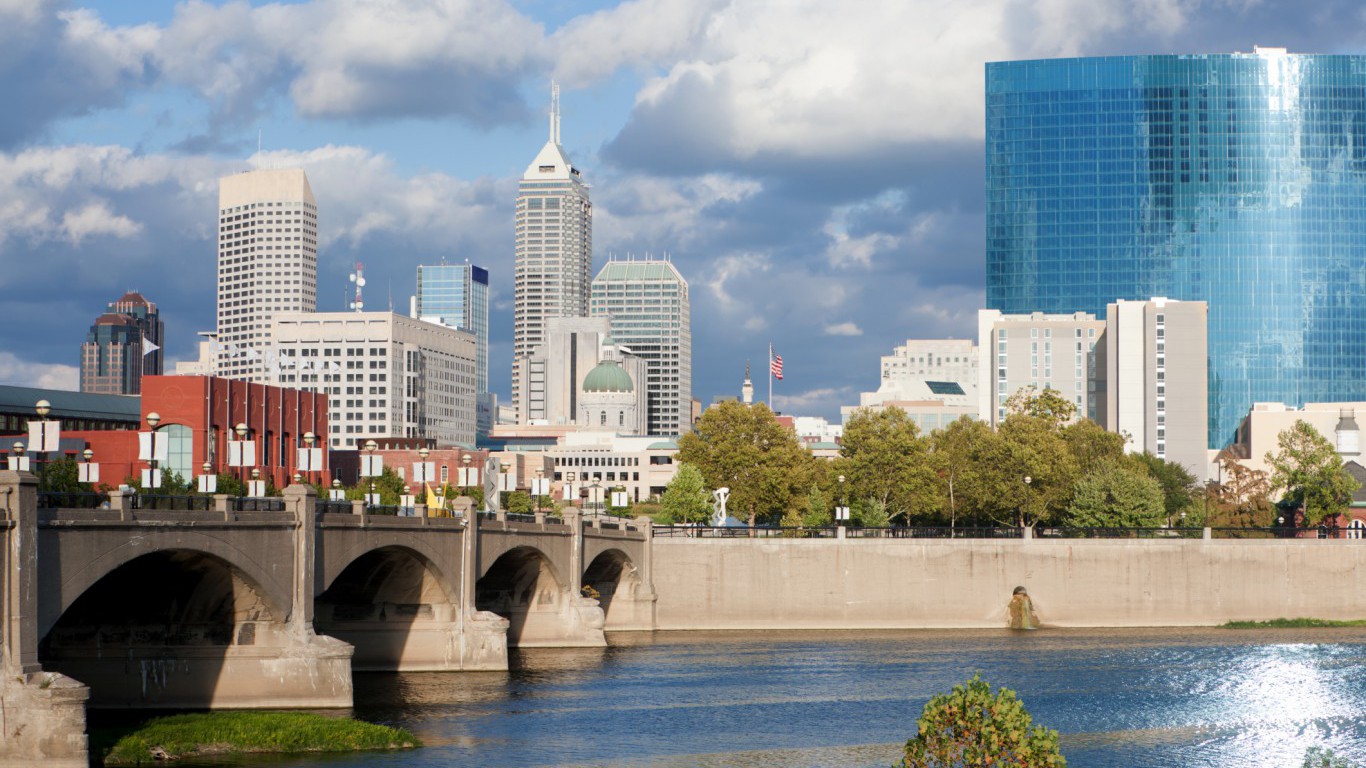
42. Indiana
> Pct. of adults with at least a bachelor’s degree: 25.6%
> Median earnings for bachelor’s degree holders: $48,790 (24th highest)
> Median household income: $52,314 (16th lowest)
> 2016 unemployment: 4.4% (21st lowest)
Only about 1 in 4 adults in Indiana have a bachelor’s degree, a smaller share than in the vast majority of states. A college education may not be necessary for a relatively large share of the labor force in the state, however. Some 18.8% of Indiana’s workers are employed in manufacturing, the largest share of any state. Far from struggling economically, only 4.4% of Indiana’s labor force was out of work in 2016, well below the 4.9% annual U.S. unemployment rate.

43. Oklahoma
> Pct. of adults with at least a bachelor’s degree: 25.2%
> Median earnings for bachelor’s degree holders: $44,977 (9th lowest)
> Median household income: $49,176 (9th lowest)
> 2016 unemployment: 4.9% (20th highest)
In keeping with the broader national trend, the share of adults in Oklahoma with a bachelor’s degree climbed over half a percentage point in 2016. However, breaking from the national trend, Oklahoma’s economy worsened in 2016, as annual unemployment spiked from 4.4% to 4.9%. Meanwhile, unemployment nationwide fell from 5.3% to 4.9%. States with better educated populations tend to have healthier economies. In Oklahoma, only 25.2% of adults have a bachelor’s degree, well below the 31.3% share of adults nationwide.

44. Alabama
> Pct. of adults with at least a bachelor’s degree: 24.7%
> Median earnings for bachelor’s degree holders: $48,304 (25th highest)
> Median household income: $46,257 (5th lowest)
> 2016 unemployment: 6.0% (4th highest)
Alabama is one of only seven states where fewer than 1 in every 4 residents 25 and older have a college degree. Many states with low educational attainment rates have lagging economies — and Alabama is among them. Nearly 10% of households in the state earn less than $10,000 a year, and 6.0% of Alabama’s labor force is out of a job, each among the highest such shares of any state.
[in-text-ad-2]

45. Nevada
> Pct. of adults with at least a bachelor’s degree: 23.5%
> Median earnings for bachelor’s degree holders: $46,908 (19th lowest)
> Median household income: $55,180 (24th lowest)
> 2016 unemployment: 5.7% (8th highest)
Only 23.5% of adults in Nevada have a bachelor’s degree, one of the smallest shares of any state. However, Nevada’s economy is such that a highly educated workforce may not be necessary. Some 25.6% of workers in the state are employed in the arts, entertainment, recreation, and accommodation sector — by far the highest such share of any state and well above the 9.8% of workers in the sector nationwide. Jobs in the sector typically do not require a college education.

46. Kentucky
> Pct. of adults with at least a bachelor’s degree: 23.4%
> Median earnings for bachelor’s degree holders: $47,610 (24th lowest)
> Median household income: $46,659 (6th lowest)
> 2016 unemployment: 5.0% (18th highest)
A college education is one of the most practical ways for an individual to increase their earning potential. In Kentucky, the bachelor’s degree attainment rate of 23.4% is nearly the lowest in the nation and far below the 31.3% national rate. Partially as a result, a relatively large share of state residents are poor. The typical household in the state earns only $46,659 a year, over $10,000 below the income the typical American household earns. Additionally, 18.5% of state residents live in poverty, a higher poverty rate than in all but three other states.
[in-text-ad]

47. Louisiana
> Pct. of adults with at least a bachelor’s degree: 23.4%
> Median earnings for bachelor’s degree holders: $46,163 (15th lowest)
> Median household income: $45,146 (4th lowest)
> 2016 unemployment: 6.1% (3rd highest)
A highly educated workforce can a boon to a state’s economy. In Louisiana, only 23.4% of adults have earned a bachelor’s degree, nearly the smallest share of any state in the country. Also, the state’s annual unemployment rate of 6.1% is worse than in all but two other states.
College-educated adults are also more likely to be financially stable than those without a four-year education. Louisiana’s low college attainment rate may partially explain the 20.2% of state residents who live below the poverty line — the second highest poverty rate in the country after only Mississippi.

48. Arkansas
> Pct. of adults with at least a bachelor’s degree: 22.4%
> Median earnings for bachelor’s degree holders: $45,963 (12th lowest)
> Median household income: $44,334 (3rd lowest)
> 2016 unemployment: 4.0% (15th lowest)
A disproportionately large share of workers in Arkansas are employed in sectors that generally do not require a college education. For example, 14.1% of the state’s labor force is in retail trade, the sector’s highest employment concentration of any state. Indeed, only 22.4% of adults in the state have a bachelor’s degree, the third smallest share of any state and well below the 31.3% share of American adults.

49. Mississippi
> Pct. of adults with at least a bachelor’s degree: 21.8%
> Median earnings for bachelor’s degree holders: $42,130 (5th lowest)
> Median household income: $41,754 (the lowest)
> 2016 unemployment: 5.8% (7th highest)
The share of adults with a bachelor’s degree in Mississippi climbed by a percentage point in 2016, slightly outpacing the 0.7 percentage point improvement nationwide. Still, Mississippi remains the second least educated state in the country as only 21.8% of adults have earned a bachelor’s degree — nearly 10 percentage points below the national college attainment rate.
Populations with higher educational attainment typically report higher incomes. In Mississippi, the typical household earns only $41,754 a year, the lowest of any state in the country.
[in-text-ad-2]

50. West Virginia
> Pct. of adults with at least a bachelor’s degree: 20.8%
> Median earnings for bachelor’s degree holders: $42,318 (6th lowest)
> Median household income: $43,385 (2nd lowest)
> 2016 unemployment: 6.0% (4th highest)
Roughly 1 in 5 adults in West Virginia have a bachelor’s degree, the smallest share of any state in the country and over 10 percentage points below the share of adults nationwide. A college degree is one of the most common ways for workers to increase their earning potential and avoid serious financial hardship. Across West Virginia, 17.9% of adults rely on government assistance in the form of food stamps, the highest recipiency rate of any state.
The state is also home to very few high income individuals. Only 2.5% of West Virginia households earn more than $200,000 a year, the smallest share of any state.
Detailed Findings and Methodology
Educational attainment among states generally follow broader geographic patterns. While the most educated states tend to be in the Northeast, the least educated states are often in the South. Of the 10 states home to the highest shares of adults with a bachelor’s degree, eight are either in New England or otherwise along the Eastern seaboard. Meanwhile, of the 10 states home to the smallest share of college educated residents, eight are in the South.
Along with geography, income is also closely tied to educational attainment. A college education paves the way to higher paying jobs that are mostly unavailable to those with only a high school diploma. Nationwide, the typical college graduate earns $51,676 annually — nearly $22,000 more than the median income of high school graduates of $29,969.
Not surprisingly, states with higher college attainment rates tend to report higher incomes. Each of the 10 states home to the largest shares of college educated adults has a higher median household income than the median household income nationwide of $57,617. Conversely, each of the 10 states with the smallest shares of college educated adults has a lower than typical median household income.
On an individual level, educational attainment largely determines the kinds of jobs available to a worker. On a broader statewide scale, educational attainment often reflects employment composition by sector. For example, in Wyoming, a state with one of the lower college attainment rates, about 1 in 10 members of the labor force work in agriculture and mining — a sector that typically does not require a formal college education — the largest such share of any state. The state also has far higher than typical employment concentration in the construction and transportation and warehousing sector.
Meanwhile, states with higher educational attainment rates tend to have greater shares of the workforce employed in the professional, scientific, and management sector — one that typically requires at least a college degree. In Maryland, a state with one of the nation’s highest bachelor’s degree attainment rates, 15.6% of the labor force works in the professional, scientific, and management sector — the largest such share of any state. A disproportionately high share of Maryland’s labor force also work in public administration and information — both sectors with relatively high educational attainment requirements.
Just as educational attainment affects employment composition, it also appears to impact the overall strength of a state’s economy — likely due in no small part to the fact that adults with a college education are often more attractive candidates to employers. Of the 10 states home to the largest shares of college educated adults, seven had a lower annual unemployment rate than the 4.9% U.S. jobless rate in 2016. Of the 10 least educated states, on the other hand, seven had annual unemployment rates as high or higher than the U.S. figure.
To identify America’s most and least educated states, 24/7 Wall St. reviewed the percentages of adults who have completed at least a bachelor’s degree in each state from the U.S. Census Bureau’s 2016 American Community Survey. The percentage of adults who have completed at least high school or its equivalent also come from the 2016 ACS. Median household income, employment by industry, food stamp recipiency, and poverty rates also come from the 2016 ACS. We also reviewed annual average unemployment data from the Bureau of Labor Statistics for 2015 and 2016.
Find a Qualified Financial Advisor (Sponsor)
Finding a qualified financial advisor doesn’t have to be hard. SmartAsset’s free tool matches you with up to 3 fiduciary financial advisors in your area in 5 minutes. Each advisor has been vetted by SmartAsset and is held to a fiduciary standard to act in your best interests. If you’re ready to be matched with local advisors that can help you achieve your financial goals, get started now.
Thank you for reading! Have some feedback for us?
Contact the 24/7 Wall St. editorial team.
 24/7 Wall St.
24/7 Wall St. 24/7 Wall St.
24/7 Wall St. 24/7 Wall St.
24/7 Wall St.

